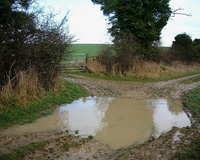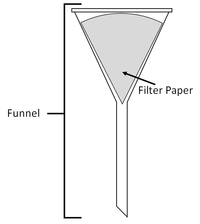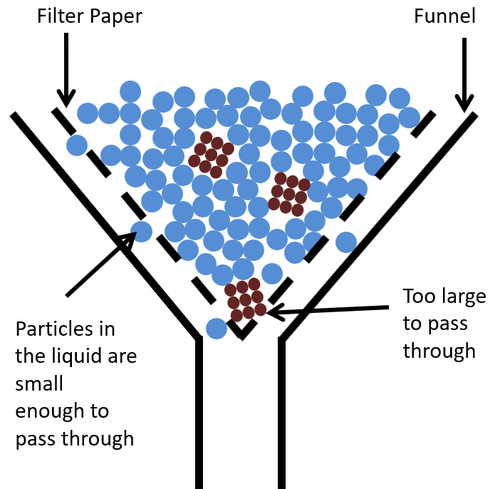Difference between revisions of "Filtration"
(→Key Stage 3) |
(→About Filtering) |
||
| Line 26: | Line 26: | ||
: Only [[insoluble]] [[solid]]s can be separated by '''filtering'''. | : Only [[insoluble]] [[solid]]s can be separated by '''filtering'''. | ||
: '''Filtering''' uses a '''filter''' that has very small holes in it that allow the [[particle]]s in the [[liquid]] through, but not the lumps of [[solid]]. | : '''Filtering''' uses a '''filter''' that has very small holes in it that allow the [[particle]]s in the [[liquid]] through, but not the lumps of [[solid]]. | ||
| + | {| class="wikitable" | ||
| + | |- | ||
| + | |[[File:FiltrationParticleDiagram.png|center|500px]] | ||
| + | |- | ||
| + | | style="height:20px; width:500px; text-align:center;" |This [[diagram]] shows how the [[insoluble]] [[solid]] gets stuck in the [[Filter Paper|filter paper]] while the [[particle]]s in the [[liquid]] are small enough to pass through the gaps in the [[Filter Paper|filter paper]]. | ||
| + | |} | ||
Revision as of 11:32, 27 September 2018
Contents
Key Stage 2
Meaning
Filtering is when you separate liquid from insoluble solids.
- Noun: Filtration
- Verb: To filter
- Present Participle: Filtering
- Adjective: Filtered
About Filtering
- Filtering cannot separate anything dissolved in a liquid.
- When you filter the solid will get stuck in the filter paper and the liquid will pass through.
Examples
| You can separate mud from water in the puddle with filter paper and a funnel. |
Key Stage 3
Meaning
Filtration is the process of separating a mixture of a liquid and an insoluble solid.
About Filtering
- Only insoluble solids can be separated by filtering.
- Filtering uses a filter that has very small holes in it that allow the particles in the liquid through, but not the lumps of solid.
| This diagram shows how the insoluble solid gets stuck in the filter paper while the particles in the liquid are small enough to pass through the gaps in the filter paper. |



